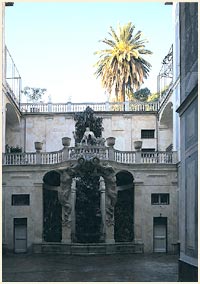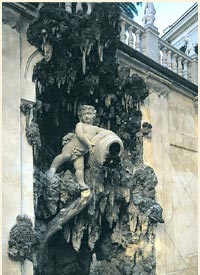The scenographic nymphaeum is placed at the end of the junction axis among the atrium, the entrance hall and the courtyard. This type of "rustic fountain" points to the evolution of the local taste, which during the 17th century turns the traditional artificial caves of the sixteenth century into open nymphaea overlooking the natural spaces.
As from the half of the seventeenth century approximately, the city palaces open up towards the outside, in a quest of continuous exchange, visual and illusive at the same time, between the nature of the garden and the decoration of the rooms.
This nymphaeum was likely built by Pallavicini family right after the purchase of the Palace (1711) and represents one of the décor works to modernize the residence along with the frescoes on the second state floor.
The majestic look of the fountain - which exploits the water coming from the water tank located on the hill of Castelletto at the rear - was a project from Domenico Parodi, then carried out by Biggi.
The height of this nymphaeum is carefully devised to give continuity to the Palace and the rearward hill, thus creating a 'trompe l'oeil' of two nymphaea in an iconographical relation one with the other, the first at the courtyard level and the second one above the terrace.
Uppermost is a vast garden placed on two layered levels shelved "on the hillside", as had become custom in the area.
The vault of the big nymphaeum is supported by two giant tritons, who framed a scene inspired to the myth of Phaeton which unfortunately got lost. Alizeri back in 1875 mentioned in his Guide that the work of "Phaeton turned upside down from the sky and above him a small spirit pouring water from an urn", ornamented with stucco and placed above the big arch was already lost at that time.
The young Phaeton, son of the Sun, upon insistence was allowed to drive just for one day his father's cart but, being unable to hold up the fiery horses, he burned out of rash the Sky and the Earth, and for this reason Zeus hit him with a lightning and made him fell into a river.
The plan (inv. no. 4667) of this nymphaeum is preserved at the museum of Palazzo Rosso.
During the restoration works, the fountain has been carefully cleaned and brought back to its original splendour, to catch the attention of the visitors and fascinate them.
In Strada Nuova a second palace, which once belonged to Pantaleo Spinola, hosts another picturesque nymphaeum, a mosaic one, where it is placed a statue representing (The Abduction of Elena), carved by Pierre Puget.
Also in this case, the opening of the palace towards the natural space was meant to enhance the magnificence of the baroque decoration of the rooms and extend its visual perception.


Detail of the Nymphaeum after the last restoration works
